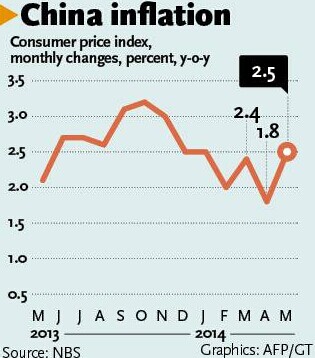

China's consumer inflation in May quickened at the fastest pace for four months but there was a moderate decline in producer price inflation, giving policymakers more room for policy easing if needed to arrest an economic slowdown.
The consumer price index (CPI), a major gauge of inflation, rose 2.5 percent in May year-on-year, accelerating from a 1.8 percent rise in April, the National Bureau of Statistics (NBS) said Tuesday. The May inflation was the highest since February, but still well below the government full-year target of 3.5 percent.
Food prices, which account for about one-third of the CPI calculation, rose 4.1 percent in May from a year ago, the data showed. The 4.1 percent rise in food prices lifted the inflation by 1.35 percentage points.
"The 2.5 percent inflation rate, though the highest in months, remained moderate. Even if it rose to 2.7 percent, it is still in a reasonable range, matching current economic growth rate," Cai Jin, deputy head of the China Federation of Logistics and Purchasing, which tracks activity in both the manufacturing and service sectors, told the Global Times Tuesday.
"The moderate rise in consumer inflation leaves the government more room to ease monetary policy and use other tools to stabilize the economy if necessary," Cai said.
The producer price index (PPI), which measures the price changes for major commodities by manufacturers at the wholesale level, dropped 1.4 percent year-on-year in May, the 27th consecutive month of decline, Tuesday's data showed. But the decline narrowed from a 2 percent drop in April and was the lowest drop in five months.
Month-on-month, PPI declined 0.1 percent in May, compared with a 0.2 percent fall in April.
"The continuous narrowing of decline of PPI on both a year-on-year and month-on-month basis showed that demand for industrial products is picking up," Yu Qiumei, a senior statistician with the NBS, said in a statement posted on the NBS website.
To stabilize the economy, which grew 7.4 percent year-on-year in the first quarter, the central government has announced a series of targeted measures including targeted monetary easing, speeding up investment in railway construction, renovation of run-down areas and energy projects.
On Monday, the central bank announced a cut in the reserve requirement ratio (RRR) by 0.5 percentage points for banks that issue significant amount of loans to the agricultural sector and small firms, effective from June 16.
This came after another RRR cut for rural commercial banks in late April. The two cuts were referred to by analysts as targeted monetary easing and fanned discussion on whether targeted measures could save the economy from a further slowdown and whether all-out policy easing will follow.
"On the policy side, the government still holds onto commitment to reforms and let the market play a decisive role in allocating resources," Zhang Lei, a macroeconomic analyst at Minsheng Securities, told the Global Times Tuesday.
"But it's only for the agricultural sector and small and micro-sized enterprises, which are in a disadvantaged position under market rules, that the government will step in with targeted measures. That's the thinking behind the recent targeted RRR cut but not a move toward broad policy easing," Zhang said.
Wang Tao, a Hong Kong-based economist for financial services company UBS, also suggested that addressing small and micro-sized enterprises and private sector financing difficulties require structural reforms and, in the short term, targeted credit easing, while a whole-sale monetary and credit easing would be less effective and could exacerbate structural imbalances.
The problems in the real economy are not caused by too little credit. It is time for structural reforms and restructuring of the real economy to carry greater weight instead of monetary policy, Wang said in a research note e-mailed to the Global Times Tuesday.
The NBS is due to release a series of economic data Friday including the retail sales, fixed-asset investment and property sales, which will give a better light of how the economy runs, even though some earlier data including manufacturing, services and trade showed improvement in May.
China‘s inflation up as economy stabilizes
2014-06-11China stresses ‘targeted‘ economic control
2014-06-11PBOC clarifies sectors targeted for support
2014-06-11May CPI statistics show China’s economy picking up
2014-06-10China‘s CPI reaches 4-month high at 2.5 pct
2014-06-10China‘s CPI up 2.5 percent in May
2014-06-10Copyright ©1999-2018
Chinanews.com. All rights reserved.
Reproduction in whole or in part without permission is prohibited.